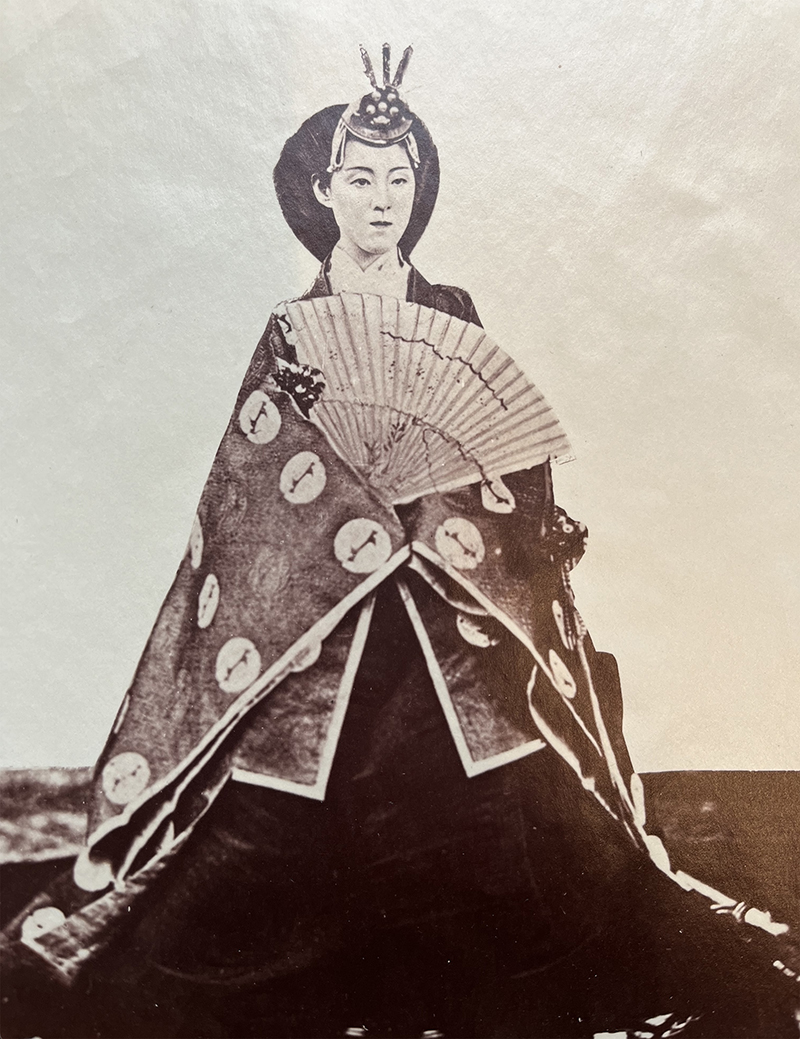Object of the Month: "Portrait of Empress Consort Haruko," 1872
By Bowdoin College Museum of Art
Portrait of Empress Consort Haruko, 1872, albumen print, by Uchida Kuichi, Japanese, 1844–1875. Bowdoin College Museum of Art, Museum Purchase, Gridley W. Tarbell II Fund, 2023.6.
This albumen photograph offers a rare glimpse into the Imperial House of Japan during the Meiji Restoration (1868–1912), a period of pronounced social, political, and economic change during which Japan began to emerge as an industrialized nation with increasingly global connections. At the center of the Meiji Restoration was Emperor Meiji (born Mutsuhito, 1852–1912), the first monarch of the Empire of Japan who ruled from 1867 until his death in 1912. As was custom during the Meiji period, the Emperor was considered a divine being and was rarely seen in public. It was not until 1872 that the Imperial Court sanctioned photographer Uchida Kuichi to make a series of official portraits of the Emperor and his family, including his wife, the Empress Consort Haruko who is seen here in full ceremonial court dress. This photograph remains one of the most widely circulated portraits of the Empress.
Born Masako Ichijō in 1849, Empress Consort Haruko married Emperor Meiji of Japan in 1869. She was the first to receive the title “Empress Consort,” and became the adoptive mother of the future Emperor Taishō and grandmother of Hirohito, who would succeed Taishō as Emperor in 1926. An intellectually gifted child, Empress Consort Haruko had an influential life, known for her diplomacy, charity work, and support of women’s education. She established the Japanese Red Cross Society (which ministered aid throughout the First Sino-Japanese War) and raised money for the International Red Cross (the Empress Shōken Fund is still used for global welfare causes today). Although shown here in traditional court garb, other images produced during the 1872 portrait session pictured the Emperor and Empress in everyday attire. The following year, Uchida created a second set of portraits that portrayed the Emperor in his Western-style military attire, which eventually became his official Imperial portrait. By the late 1880s, the Empress would publicly lobby for the adoption of Western-style attire as more befitting a modern woman—a reflection of the many social changes that unfolded during the Meiji Restoration.
While never rising to the level of fame enjoyed by his Imperial sitters, Nagasaki-born Uchida Kuichi (1844–1875) is widely celebrated as the most talented Japanese photographer of the nineteenth century. After his father's death in 1863, Uchida was adopted by Matsumoto Jun, a doctor who was studying photography with the Dutch physician and chemist J. L. C. Pompe van Meerdervoort. While in his early teens, Uchida took up the art himself, apprenticing with Ueno Hikoma in Nagasaki before opening the first photography studio in Osaka in 1865. Uchida would subsequently establish studios in Yokohama and Tokyo. His renown was such that, in 1870, a kabuki play was written and performed about his life. Uchida’s sessions with the Imperial family were the pinnacle of an abbreviated career, one cut short when the artist died at age 32 from tuberculosis.
This recent acquisition is an important addition to the Museum’s collection of nineteenth-century photography. Uchida’s portrait of Empress Consort Haruko will join other photographs, prints, drawings, and paintings in the exhibition Face Forward: Recent Acquisitions, which highlights the work of artists who explore portraiture as a form of artistic experimentation, social commentary, and a meditation on identity. Face Forward will be on view from November 30, 2023 through March 10, 2024 in the Becker Gallery.
Cassandra BraunCurator, Bowdoin College Museum of Art